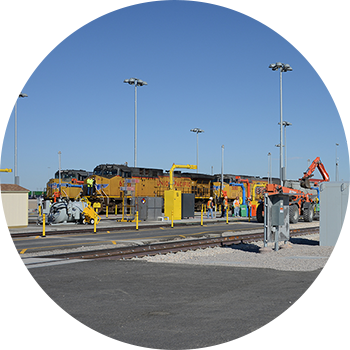Forget Disneyland: I'm Going To Santa Teresa
A year after Union Pacific's intermodal terminal and locomotive fueling facility officially opened in April 2014, Santa Teresa has become one of the state's hottest industrial areas, building upon the momentum that began when the railroad started planning the new facility years earlier.
Jerry Pacheco, who operates the Border Industrial Association (BIA), which represents the industrial base from Santa Teresa to Las Cruces, New Mexico, calls it the "Disneyland Effect."
"Think about all the businesses that popped up around Disneyland," he said. "The curio stores, the T-shirt shops, the gas stations – they're not associated with Disneyland, but they want to be there because it's an attractive place to be."
When it comes to Santa Teresa, there are two Disneylands. One is the Union Pacific facility; the other is computer maker Foxconn, whose factory sits on the other side of the Mexican border just a few miles away.
"We're sandwiched between these industrial zones, between these two projects that have attracted international attention," Pacheco said. "If your company is here, you get superior logistics. You have the capability of doing business on the other side of the border. There's no better place to be, and that's the Disneyland concept."
To prove his point, Pacheco rattled off a list of companies that have either been established or grown since Union Pacific announced its Santa Teresa facility, including:
- Twin Cities Services, a container hauler and storage company
- Transmaritime Inc., a transloader and warehouse facility
- ERO Intermodal Services, a company that maintains and repairs truck chassis and containers that also supplies partsvfor heavy equipment
- The Santa Teresa Southern Railroad, a private railroad thatvconnects businesses with Union Pacifc's main line
- Stagecoach Cartage and Distributing, a 10-acre transload,vwarehousing and drop yard
- W Silver Recycling, which will use rail to transport recycled metals,
- CN Wire Corporation, which opened a 258,000-square-foot facilityvthat employs 300
And, of course, Penny's Diner and the Oak Tree Inn, which sits in the center of the industrial park. "We've got everything from warehousing to logistics and manufacturing," Pacheco said, "all located within seven or eight miles of the Union Pacific facility."
He said Santa Teresa boasts more than 3.3 million square feet of industrial space, but a year after Union Pacific moved its container business from east El Paso to the new Santa Teresa facility, only 8,000 square feet remained available.
"Union Pacific gave us the opportunity not only to recruit existing businesses that came from El Paso, it allowed us to bring in new regional business," Pacheco said. "We've got a little over 3,000 people working in these parks. Not too long ago, that number was between 1,200 and 1,500, so we've more than doubled the jobs."
Even more dramatic changes could be on their way with the creation of the Westpark Logistics Center, a 166-acre development christened just last month. One of the largest industrial parks in New Mexico – and the closest to Union Pacific's intermodal facility – Westpark's first tenant will be MCS Industries, a U.S. picture frame manufacturer.
"Companies ask me, 'What's my investment going to be worth in 10 years?'" Pacheco said. "Well, it's going to be worth quite a bit because this is a hot place, and if you buy in early and you build your plant here, you're going to be in a sweet, sweet position. The value's not going to go down, and we have so much room around Union Pacific, there's still plenty of time to come in and set up your plant."
Attracting more business to rail also offers environmental benefits. According to the U.S. Environmental Protection Agency, freight trains are nearly four times more fuel efficient than trucks.


